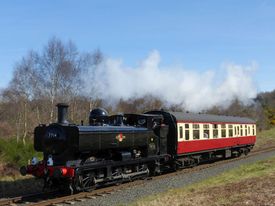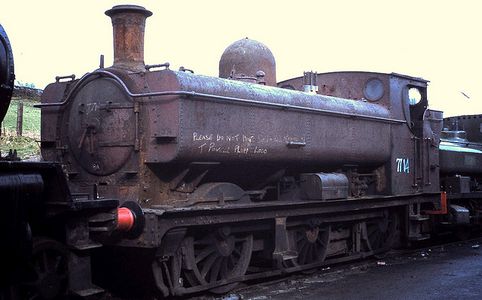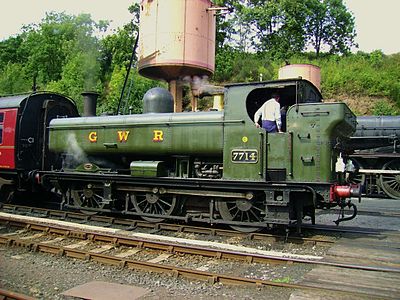GWR Pannier 7714
| GWR Pannier 7714 | |
|---|---|
 7714 near Bewdley Tunnel (March 2017) | |
| Built By | Kerr Stuart & Co., Stoke |
| Configuration | 0-6-0PT |
| Power class | GWR: C, BR(W): 4F |
| Axle load class | GWR: Blue (Yellow from 1950) |
| Status | In Service |
| Loco Number | 7714 |
| History | |
| Built | 1930 |
| Designed By | Charles Collett |
| Type | GWR 5700 |
| 1973 | Arrived on the SVR |
| 2009 | Withdrawn for overhaul |
| 2016 | Return to service |
| Technical | |
| Length | 31ft 2" |
| Weight | 47t 10cwt |
| Tractive effort | 22,515 lb |
| Pressure | 200 lb/sq in |
7714 is a GWR Collett 5700 class 0-6-0PT 'pannier tank', one of two examples on the SVR (the other being 5764).
Contents
GWR Collett 5700 class
The 5700 class was the most numerous class of engine designed and built by the Great Western Railway. More than 860 were constructed between 1929 and 1950, of which 250 were built by outside contractors rather than at Swindon. Pannier tanks could be found at work all over the former GWR system and although designed primarily for shunting duties (which they carried out at Kidderminster Goods Yard and elsewhere), they were regularly used on local freight and passenger workings in which capacity they served on the Severn Valley Branch until closure. Fittingly, on Sunday 8 September 1963 the final 6.58pm Bridgnorth to Birmingham Snow Hill train, normally a diesel railcar service, was hauled by ex-GWR pannier tanks 9624 and 4665 carrying a 'Special Last Train' headboard.
British Railways Western Region 'BR(W)' rated the class as 4F,[1] although elsewhere the class was rated 3F.[2]
7714 in service
Lot 263, the batch from 7700-7724, were built in 1930 under contract by Kerr Stuart & Co. of Stoke with vacuum brakes and steam heating, and fitted with riveted tanks and polished brass safety valve covers. The visible rivets on the water tanks are a sign of its non-Swindon origin. The batch was one of several partly funded by interest-free Government loans intended to relieve unemployment during the 'Great Depression'.[3] 7714 was built at a reported cost of £3,160 as works no 4449 of 1930 and entered service at Tyseley in April of year. It was one of the last locomotives produced by that manufacturer, which was wound up later that year.[4] GWR ATC was added a few years after delivery.
Apart from a brief transfer to Leamington in late 1931, it remained at Tyseley until moving to Birkenhead in November 1937. It then remained at Birkenhead, apart from a month at Oxley Wolverhampton in spring 1947, until December 1958, when a final move to Wrexham Croes Newydd took place. It was withdrawn by BR in January 1959, having run an estimated 520,259 miles in service.[5]
7714 was sold to the National Coal Board for use at their Penallta Colliery near Rhymney in South Wales, moving the following July. Initially used daily, the long wheelbase proved unsuitable for the tight curves in the track there so it mostly acted as a spare engine.[5]
7714 in preservation
Representatives of the SVRA Kidderminster Branch's Pannier Tank Fund inspected 7714 and chose it in preference to sister 7754, then at Mountain Ash, Mardy. The Fund tendered £1,750 and completed the purchase on 3 January 1973.[6] Caudles duly delivered 7714 by road to Bridgnorth on 29 March. The Fund had already acquired 5764 (L95) two years earlier.
As with other ex-NCB locomotives it was in a very worn condition, with all wheels sporting dangerous 'double flanges'. After the boiler was lifted from the frames at Bridgnorth Loco Works, both were transported to Bewdley Down Yard "in a number of wagons" in late 1974. A lengthy restoration then followed, although little work took place until late 1977 while the Fund concentrated its efforts on paying off loans.[7] In 1979 an SVRA raffle was held to raise funds for the restoration.[8] In spring 1985 another SVRA raffle was held to raise funds for contract work on the motion and the boiler. A total of around £5,600 nett was raised in this raffle.[9] In Spring 1989 “The Final Frontier” raffle organised by the SVRA Kidderminster Branch was held to raise money for the boiler, realising just over £6,000 after expenses.[10]
The locomotive was first steamed in July 1992[11]. It was outshopped in BR Black livery and after wintering in Kidderminster Carriage Works paint shop, emerged on the first weekend as the only steam locomotive working on a shortened railway due to engineering works taking place at the north end of the line. Unfortunately on its first trip it ran a hot coupling rod bush; the offending items were taken to Bridgnorth by road to be re-metalled.[12]
Since arrival 7714 had always faced north, however when classmate 5775 arrived on hire from the Worth Valley in June 1993 the low loader was used to turn 7714 to face south, enabling it to take part in triple-headed trains with 5764 and 5775 during that year's Autumn Steam Gala.[13][14]. It saw regular use, especially on winter services, and also saw service at the South Devon Railway in 1995 and the East Somerset Railway in 1996.[5].
In mid-1999 the locomotive was repainted into GWR green livery. Shortly afterwards it suffered an issue with the driving stub-axle working loose. This was sent away for repair at the British Steel workshops near Redcar. The repair was successful with the axle reinstalled by the winter. Around this time the boiler also received an overhaul at Crewe Heritage Centre, with a return to service in summer 2000.[15]
In Spring 2006 an SVRA raffle was held to help raise funds for a new crank axle, further movement of the crank since the earlier repair having led to restrictions in train loadings. The raffle raised around £12,000 net of costs etc.[16] After working in each of the years 1992 to 2009, 7714 was withdrawn from service in August 2009 with a boiler issue.[17] The locomotive then spent a period on display in The Engine House, before being moved to Bridgnorth in April 2012 for overhaul.[18] It is thought the damage to the right hand half of the cylinder casting occurred during its NCB ownership. In 2014 a second SVRA raffle 'The Prized Pannier' raised around £20,000 gross towards the overhaul costs.[19] The riveting of the boiler barrel had been completed by January 2016, with the boiler passing its out of frames steam test in August 2016.[20] The locomotive was painted in BR black at Bridgnorth during October 2016,[21] with the overhaul being completed in November 2016.[22]
During 2019, 7714 recorded 9,254 miles, the highest mileage of any of the fleet in the year. At the end of that year, 7714 had recorded a total of 85,063 miles in preservation on the SVR. The reported total may include mileage on hire to other railways.[23] In 2023 it again recorded the highest of 4,247 miles over 75 steaming days, reflecting the significantly reduced fleet mileage.[24]
The locomotive is now owned by the SVR Pannier Tank Fund, who also own GWR Pannier 5764.
In late 2022 7714 had a repaint, remaining in BR black but with the early crest and red-backed cabside numberplates.
See also
References
- ↑ Midlands Division (Ex WR) & Gloucester District - Locomotive Route Availability (Branch Lines)- June 1963 Retrieved 7 January 2017
- ↑ Classic British Steam Locomotives (ISBN 1-86147-138-6), Wikipedia etc
- ↑ le Fleming, H.M., 'The Locomotives of the Great Western Railway, Part 5: Six-coupled Tank Engines', Oxford: RCTS (April 1958), ISBN 0-901115-35-5
- ↑ Ferris (1995) p. 29
- ↑ 5.0 5.1 5.2 SVR Stock Book 9th edition
- ↑ Private correspondence from the Pannier Tank Fund, March 2023
- ↑ SVR News 46, The Saga of the Pannier Tanks, John Hill
- ↑ SVR News 52
- ↑ SVR News 75, 77
- ↑ SVR News 91, 93
- ↑ SVR News 105
- ↑ SVR News 106
- ↑ SVR News 118
- ↑ SVR News 115, North and South before the Turntable, Quentin Haigh
- ↑ SVR News 130-133
- ↑ SVR News 153, 155
- ↑ SVR News 167
- ↑ SVR News 179
- ↑ SVR News 189
- ↑ SVR Forum
- ↑ SVR Live 'Ex-GWR 0-6-0PT No. 7714'
- ↑ SVR Meet the Locomotives page
- ↑ SVR News 210, SVR-based Steam Locomotive Mileage 2017-2019, Duncan Ballard
- ↑ SVR News 225
Links
| ||||||||||||||||||||||||||||||||||||||||||||||||||||||||

